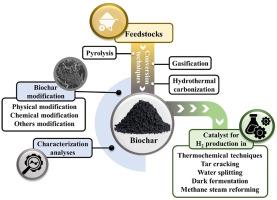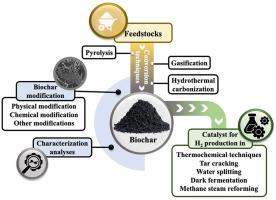Progress and development of biochar as a catalyst for hydrogen production
IF 11.3
1区 化学
Q1 CHEMISTRY, PHYSICAL
引用次数: 0
Abstract
The recent progress of the biochar application as a catalyst for the production of hydrogen has been presented in this review. Biochar is a carbon-rich material, which can be produced through different thermochemical conversions (pyrolysis, gasification, and hydrothermal carbonization) using various feedstocks. Biochar has gained attention as a possible catalyst for the production of hydrogen in recent years. It has a distinctive structure and multiple functions and can be accessed widely. The utilization of biochar as a catalyst can significantly improve the hydrogen yield and quality, showing improved catalytic activity and thermal stability. The physiochemical characteristics of biochar are also affected by the different types of feedstocks. Furthermore, the biochar performance can be increased as a catalyst when it is modified with alkali, acid, metal ions, carbonaceous materials, oxidants, purging of gas, and steam. This review presents an overview of the feedstock, production, modification, and characterization methods of the biochar, followed by an elaborate discussion on the application of biochar as a catalyst. This paper addresses the current development of biochar as a catalyst/support for hydrogen production in thermochemical techniques, photocatalytic water splitting, dark fermentation, and methane steam reforming. Overall, biochar catalyst has the potential for a cleaner and more effective energy system.


生物炭作为制氢催化剂的进展与发展
本综述介绍了将生物炭用作制氢催化剂的最新进展。生物炭是一种富碳材料,可以利用各种原料通过不同的热化学转化(热解、气化和水热碳化)生产出来。近年来,生物炭作为一种可能的制氢催化剂备受关注。生物炭具有独特的结构和多种功能,可广泛获取。利用生物炭作为催化剂可以显著提高氢气产量和质量,并显示出更高的催化活性和热稳定性。不同种类的原料也会影响生物炭的理化特性。此外,用碱、酸、金属离子、碳质材料、氧化剂、净化气体和蒸汽对生物炭进行改性,可提高生物炭作为催化剂的性能。本综述概述了生物炭的原料、生产、改性和表征方法,随后详细讨论了生物炭作为催化剂的应用。我们讨论了生物炭作为催化剂/支持物在热化学技术、光催化水分离、黑暗发酵和甲烷蒸汽转化中制氢的当前发展情况。总之,生物炭催化剂有可能成为更清洁、更有效的能源系统。
本文章由计算机程序翻译,如有差异,请以英文原文为准。
求助全文
约1分钟内获得全文
求助全文
来源期刊

ACS Catalysis
CHEMISTRY, PHYSICAL-
CiteScore
20.80
自引率
6.20%
发文量
1253
审稿时长
1.5 months
期刊介绍:
ACS Catalysis is an esteemed journal that publishes original research in the fields of heterogeneous catalysis, molecular catalysis, and biocatalysis. It offers broad coverage across diverse areas such as life sciences, organometallics and synthesis, photochemistry and electrochemistry, drug discovery and synthesis, materials science, environmental protection, polymer discovery and synthesis, and energy and fuels.
The scope of the journal is to showcase innovative work in various aspects of catalysis. This includes new reactions and novel synthetic approaches utilizing known catalysts, the discovery or modification of new catalysts, elucidation of catalytic mechanisms through cutting-edge investigations, practical enhancements of existing processes, as well as conceptual advances in the field. Contributions to ACS Catalysis can encompass both experimental and theoretical research focused on catalytic molecules, macromolecules, and materials that exhibit catalytic turnover.
 求助内容:
求助内容: 应助结果提醒方式:
应助结果提醒方式:


